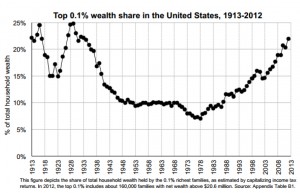
According to the report, the current share of national wealth by the wealthy few and the declining share of middle class wealth is as unsustainable today as it was before the economic crashes of 2008 and 1929.
The middle class share of wealth has declined to unsustainable levels over the last three decades, according to a new report by economists Emmanuel Saez of the University of California Berkeley, and Gabriel Zucman of the London School of Economics.
The report, titled, Wealth Inequality in the United States since 1913: Evidence from Capitalized Income Tax Data, shows that while America’s middle class is struggling, those at the top 1 percent—which includes about 160,000 families with net assets over $20 million in 2012—now hold 22 percent of our country’s wealth. In contrast, the wealth of the middle class fell from 35 percent in the mid-1980s to about 23 percent in 2012. According to the report, the current share of national wealth by the wealthy few and the declining share of middle class wealth is as unsustainable today as it was before the economic crashes of 2008 and 1929.
Income inequality has become part of the national conversation, and Saez and Sucman join the growing chorus of academics, economists and even some politicians who have warned that the widening gap between the wealthy few and the rest of us is having a detrimental effect not only on the economy, but our society as a whole.
